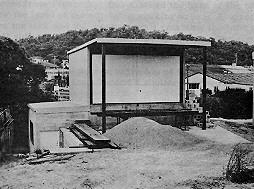Posted 13 September 2010

The experimental facility used for the work published in WRL Research Report No. 126 in 1972
The Water Research Laboratory (WRL) has a long history of fundamental research into groundwater. This research was published in the Research Report series of the WRL and sent to exchange libraries around the world.
The reports were available in the Water Reference Library at Manly Vale in Sydney. However, as the years have gone by, awareness of these gems has dwindled and the reports were seldom accessed.
A project financed by the current WRL project staff has digitised all the vintage WRL Research Reports and to made them available through the UNSW Library.
UNSW PhD theses are also now available from this site.
A groundwater research team was established at WRL by Colin Dudgeon starting in 1964. Flow of water through coarse granular materials was WRL Research Report No. 76 published in 1964. This early work led to several major research projects funded by the Australian Water Resources Council. Project 68/8: Extraction of Water from Unconsolidated Sediments was published as WRL Research Report No. 126 in 1972. This report was presented as 2 volumes.
Volume 1 - Theoretical and Experimental Studies comprising 4 parts:
Volume 2 - Field Studies:
The experimental facility was a unique, specially-designed concrete tank 4.94m by 4.94m by 3.35m deep which could be used to test non-linear flow of groundwater to wells and excavations.
The well tank facility remains at WRL. The pumping test data is extensive and included multiple piezometers at different depths close to an abstraction well, piezometers set in the gravel pack of abstraction bores and more distant observation points.
All the tests were analysed using 2D radial flow models constructed using finite element code.
Other notable works that emerged from this research program were early prototypes of the dip meter and the heat-pulse flow meter.
The group at the WRL included the students Peter Huyakorn and Ron Cox working with Colin Dudgeon.
Peter Huyakorn's PhD thesis was submitted in October 1973 and described the theoretical analysis of two-regime flow of groundwater. The thesis was published in 1974 as Research Report 137.
Ron Cox's thesis was a study of near well groundwater flow and the implications for well design. This thesis was published as Research Report 148 in March 1977.
Colin Dudgeon's attention to detail is clearly demonstrated in his own PhD (finally published as WRL Research Report No 162 in 1985) where he carefully examines the upper and lower limits of Darcy's Law.
Work on the upper limits, where laminar flow breaks down, forms much of the background to this Research Report but is also extended here to cover flow into large diameter pits, providing extensive practical results of direct use in the mining industry. Work on the lower limit is also fascinating and shows that estimates of groundwater flow at very low hydraulic gradient s, such as in the Great Artesian Basin may be overestimated.
Groundwater level monitoring data recovered at the end of 2019 from Mystery Road at Breeza on the Liverpool Plains reveals a direct connection between the Gunnedah Formation unconsolidated sands and gravels and the underlying Permian coal measures. The connection is provided by the old deep channel of the Mooki River that cuts down into the coal measures. This is a crucial piece of evidence to be incorporated into groundwater models.
What are the effects of fire on water underground? Let’s think about what happens on the surface, and translate that to what is likely to happen to the subsurface.

The effects of tidal forces on groundwater might be less apparent to us than their effects on the ocean, but they’re just as important.

Dr Oliver Knox has brought together information from some of the industry’s researchers conducting work oncotton-producing soils.
Groundwater research at ANSTO has provided crucial information to support the management of finite groundwater resources appropriately and sustainably—answering questions about groundwater recharge, groundwater age and dynamics, the interaction between surface water and groundwater and salinisation.